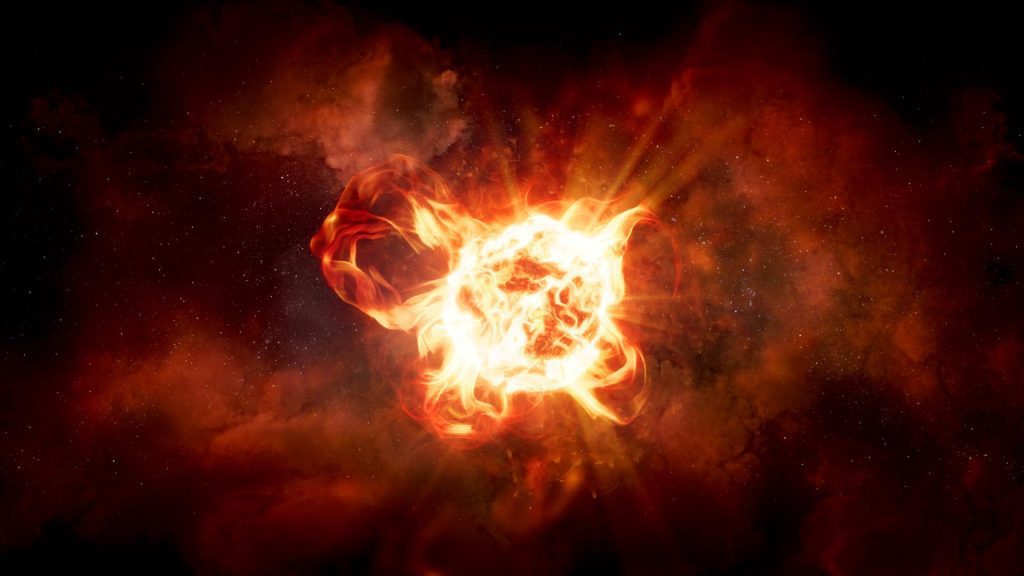
Impresión artística de la estrella gigante roja VY Canis Majoris. VY Canis Majoris se encuentra a unos 3.009 años luz de la Tierra y es probablemente la estrella más masiva de la Vía Láctea. Crédito de la imagen: NASA/ESA/Hubble/R. Humphreys, Universidad de Minnesota/J. Olmsted, STScI/hubblesite.org
Mediante el seguimiento de las emisiones moleculares en los flujos de salida alrededor de la estrella gigante roja VY Canis Majoris, los astrónomos han obtenido el primer mapa detallado de la atmósfera de la estrella, que arroja luz sobre los mecanismos implicados en las etapas finales de la estrella gigante extrema.
Un equipo de astrónomos dirigido por la Universidad de Arizona ha creado una imagen tridimensional detallada de una estrella gigante moribunda. El equipo, dirigido por los investigadores de UArizona Ambesh Singh y Lucy Ziurys, rastreó la distribución, direcciones y velocidades de una variedad de partículas que rodean una estrella roja masiva conocida como VY Canis Majoris.
Sus hallazgos, que presentaron el 13 de junio de 2022 en la reunión número 240 de la Sociedad Astronómica Estadounidense en Pasadena, California, ofrecen información, en una escala sin precedentes, sobre los procesos que acompañan a la muerte de estrellas gigantes. Robert Humphreys de la Universidad de Minnesota y Anita Richards de la Universidad de Manchester en el Reino Unido trabajaron con colaboradores.
Las estrellas gigantes extremas conocidas como hipergigantes son muy raras y solo se conocen unas pocas.[{» attribute=»»>Milky Way. Examples include Betelgeuse, the second brightest star in the constellation Orion, and NML Cygni, also known as V1489 Cygni, in the constellation Cygnus. Unlike stars with lower masses – which are more likely to puff up once they enter the red giant phase but generally retain a spherical shape – hypergiants tend to experience substantial, sporadic mass loss events that form complex, highly irregular structures composed of arcs, clumps, and knots.
Located about 3,009 light-years from Earth, VY Canis Majoris – or VY CMa, for short – is a pulsating variable star in the slightly southern constellation of Canis Major. Spanning anywhere from 10,000 to 15,000 astronomical units (with 1 AU being the average distance between Earth and the sun) VY CMa is possibly the most massive star in the Milky Way, according to Ziurys.
“Think of it as Betelgeuse on steroids,” said Ziurys, a Regents Professor with joint appointments in UArizona Department of Chemistry and Biochemistry and Steward Observatory, both part of the College of Science. “It is much larger, much more massive and undergoes violent mass eruptions every 200 years or so.”
The team chose to study VY CMa because it is one of the best examples of these types of stars.
“We are particularly interested in what hypergiant stars do at end of their lives,” said Singh, a fourth-year doctoral student in Ziurys’ lab. “People used to think these massive stars simply evolve into supernovae explosions, but we are no longer sure about that.”
“If that were the case, we should see many more supernovae explosions across the sky,” Ziurys added. “We now think they might quietly collapse into black holes, but we don’t know which ones end their lives like that, or why that happens and how.”
Previous imaging of VY CMa with NASA’s Hubble Space Telescope and spectroscopy showed the presence of distinct arcs and other clumps and knots, many extending thousands of AU from the central star. To uncover more details of the processes by which hypergiant stars end their lives, the team set out to trace certain molecules around the hypergiant and map them to preexisting images of the dust, taken by the Hubble Space Telescope.
“Nobody has been able to make a complete image of this star,” Ziurys said, explaining that her team set out to understand the mechanisms by which the star sheds mass, which appear to be different from those of smaller stars entering their red giant phase at the end of their lives.
“You don’t see this nice, symmetrical mass loss, but rather convection cells that blow through the star’s photosphere like giant bullets and eject mass in different directions,” Ziurys said. “These are analogous to the coronal arcs seen in the sun, but a billion times larger.”
The team used the Atacama Large Millimeter Array, or ALMA, in Chile to trace a variety of molecules in material ejected from the stellar surface. While some observations are still in progress, preliminary maps of sulfur oxide, sulfur dioxide, silicon oxide, phosphorous oxide and sodium chloride were obtained. From these data, the group constructed an image of the global molecular outflow structure of VY CMa on scales that encompassed all ejected material from the star.
“The molecules trace the arcs in the envelope, which tells us molecules and dust are well-mixed,” Singh said. “The nice thing about emissions of molecules at radio wavelengths is that they provide us with velocity information, as opposed to the dust emission, which is static.”
By moving ALMA’s 48 radio dishes into different configurations, the researchers were able to obtain information about the directions and velocities of the molecules and map them across the different regions of the hypergiant’s envelope in considerable detail, even correlating them to different mass ejection events over time.
Processing the data required some heavy lifting in terms of computing power, Singh said.
“So far, we have processed almost a terabyte from ALMA, and we still receive data that we have to go through to get the best resolution possible,” he said. “Just calibrating and cleaning the data requires up to 20,000 iterations, which takes a day or two for each molecule.”
“With these observations, we can now put these on maps on the sky,” Ziurys said. “Until now, only small portions of this enormous structure had been studied, but you can’t understand the mass loss and how these big stars die unless you look at the entire region. That’s why we wanted to create a complete image.”
With funding from the National Science Foundation, the team plans to publish its findings in a series of papers.
Meeting: 240th meeting of the American Astronomical Society

«Experto en la web. Fanático de la cerveza exasperantemente humilde. Fanático del tocino. Creador típico. Experto en música».





More Stories
¿Cómo se hicieron los agujeros negros tan grandes y rápidos? La respuesta está en la oscuridad.
Una vaca marina prehistórica fue devorada por un cocodrilo y un tiburón, según los fósiles
El lanzamiento del cohete Falcon 9 de SpaceX se ha detenido a medida que se acercan dos importantes misiones de vuelos espaciales tripulados.